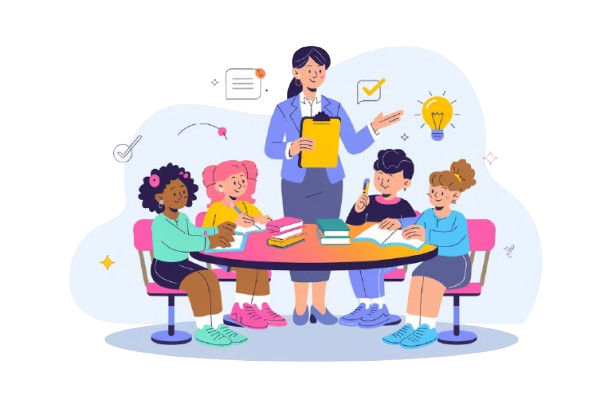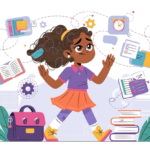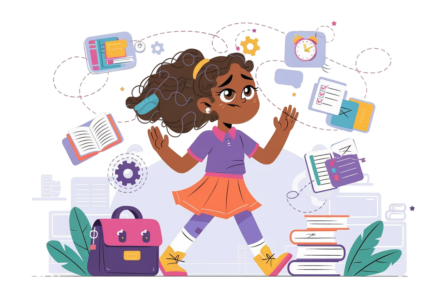
Do you sometimes feel like it’s a challenge to keep your students focused? You’re not alone. With distractions everywhere and shorter attention spans, maintaining focus can seem like a constant battle. But here’s the good news: simple, proven teaching tips for classroom focus can transform your classroom into an engaging and productive space.
In this post, we’ll explore 5 practical teaching tips for classroom focus that will help your students focus better, learn more, and thrive!
What You’ll Learn
By the end of this guide, you’ll discover:
- 5 simple ways to improve classroom focus.
- Tips to reduce distractions and boost engagement.
- Research-backed strategies for effective learning.
1. Break Lessons into Short, Engaging Segments
Research shows that students focus best in short bursts. Long lessons can cause mental fatigue and disengagement. Instead, use these teaching tips for classroom focus to keep your students attentive:
- Break your lessons into 10-15 minute segments.
- Add quick breaks or engaging activities between segments.
- Use tools like timers or visuals to manage time effectively.
📝 What Science Says: According to Edutopia, shorter lessons paired with brief breaks not only improve retention but also significantly boost classroom focus.
2. Incorporate Brain Breaks and Movement
Students are more focused when they can get up and move. Movement-based strategies break up monotony and help refresh students’ energy levels.
2.1 Brain Breaks to Boost Focus
Quick brain breaks can re-energize students and improve attention. Try:
- Stretches: Simple movements to release tension.
- Dance breaks: Play short, fun music for students to groove to.
- Breathing exercises: Help calm restless energy.
💡 Pro Tip: Use GoNoodle or similar apps to provide quick, engaging videos that encourage movement.
2.2 Interactive Teaching Tips for Classroom Focus
Interactive tasks are excellent teaching tips for classroom focus, keeping students active and engaged while they learn. These include:
- Group work: Rotate tasks to encourage collaboration and movement.
- Learning stations: Set up mini-activities at different spots in the room to keep energy levels up.
✨ Why It Works: By combining movement and interaction, these teaching tips for classroom focus help create a dynamic, productive learning environment.
3. Teaching Tips for Classroom Focus: Use Visual and Auditory Tools
Engaging multiple senses with teaching tips for classroom focus can significantly enhance learning outcomes.
3.1 Visual Tools to Boost Student Engagement
Visual aids make complex topics easier to understand and retain. Try:
- Infographics and charts: Simplify key concepts for clarity.
- Videos and animations: Bring lessons to life in an engaging way.
- Diagrams: Perfect for explaining science, math, and geography concepts.
🎓 Fact: Visual aids improve student learning by up to 400%, according to Harvard research.
3.2 Auditory Teaching Tips for Classroom Focus
Auditory tools are powerful teaching tips for classroom focus and support auditory learners effectively. Use these ideas:
- Podcasts and storytelling: Engage students with narrated lessons.
- Music and sound effects: Play soft music during group work or transitions.
- Interactive tools like Kahoot!: Make learning fun with quizzes that incorporate sound effects.
✨ Why It Works: Visual and auditory tools work together to keep students engaged, focused, and motivated to learn.
4. Teaching Tips for Classroom Focus: Set Clear Goals and Expectations
Teaching tips for classroom focus emphasize clarity and structure to keep students engaged and on track.
4.1 Setting Clear Learning Objectives
When students know what to focus on and why it matters, they stay motivated. Start each lesson with:
- Learning objectives: Clearly state the goal for the session.
- Examples: Use simple language like, “Today, you’ll learn how to solve addition problems with regrouping.”
🎯 Why It Works: Objectives give students direction and purpose during lessons.
4.2 Practical Teaching Tips for Classroom Focus
To make goals manageable and keep students on task, follow these strategies:
- Break tasks into steps: Divide larger activities into clear, actionable parts.
- Positive reinforcement: Use stickers, class points, or verbal praise to encourage progress.
- Check-ins and reviews: Periodically confirm students’ understanding and progress.
💭 Example: “Today, we will learn about ecosystems. By the end of this lesson, you’ll be able to name three types of ecosystems.”
5. Encourage Active Participation
Students learn better when they’re involved. Try these techniques:
- Use Think-Pair-Share: Students think individually, pair up to discuss, then share with the class.
- Assign roles: Group leader, timekeeper, or note-taker to keep them engaged.
- Rotate activities: Switch between group projects, presentations, and Q&A sessions.
🙌 Why It Works: Active participation boosts confidence and encourages deeper learning.

Quick Ways to Boost Focus Every Day
- Start lessons with a fun question or story to grab attention.
- Use calm background music during quiet tasks.
- Create a “distraction-free” zone for independent work.
Conclusion
Boosting classroom focus doesn’t need to be complicated. By breaking lessons into chunks, incorporating movement, and encouraging participation, you can create an environment where students stay engaged, focused, and ready to learn.
To take it a step further, consider tailoring your teaching to different learning styles. Check out our previous post, How Learning Styles Influence Student Success, for practical strategies to support visual, auditory, and kinesthetic learners.
Start with one of these tips this week and see how your classroom transforms! 🎓
Enjoyed These Tips?
Don’t miss out on more practical teaching tips and tools. Subscribe to our newsletter for the latest updates and resources!
Further Reading and Resources
For more tips and research-backed strategies, check out these resources:





2 Comments